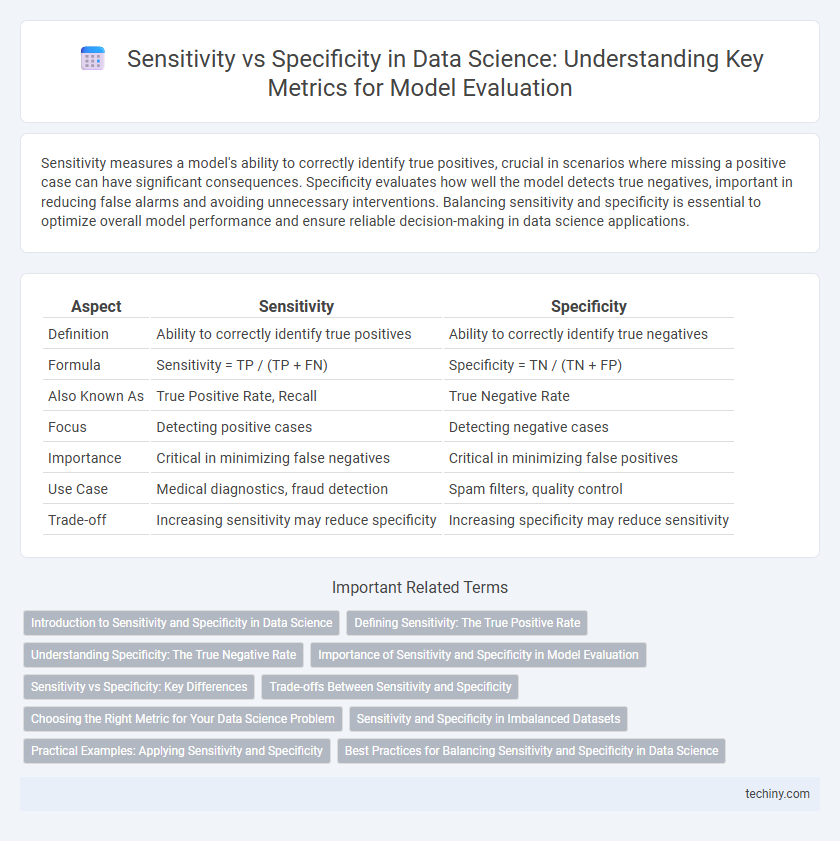Sensitivity measures a model's ability to correctly identify true positives, crucial in scenarios where missing a positive case can have significant consequences. Specificity evaluates how well the model detects true negatives, important in reducing false alarms and avoiding unnecessary interventions. Balancing sensitivity and specificity is essential to optimize overall model performance and ensure reliable decision-making in data science applications.
Table of Comparison
| Aspect | Sensitivity | Specificity |
|---|---|---|
| Definition | Ability to correctly identify true positives | Ability to correctly identify true negatives |
| Formula | Sensitivity = TP / (TP + FN) | Specificity = TN / (TN + FP) |
| Also Known As | True Positive Rate, Recall | True Negative Rate |
| Focus | Detecting positive cases | Detecting negative cases |
| Importance | Critical in minimizing false negatives | Critical in minimizing false positives |
| Use Case | Medical diagnostics, fraud detection | Spam filters, quality control |
| Trade-off | Increasing sensitivity may reduce specificity | Increasing specificity may reduce sensitivity |
Introduction to Sensitivity and Specificity in Data Science
Sensitivity measures a model's ability to correctly identify true positives, reflecting how effectively it detects relevant cases in data science applications. Specificity quantifies the accuracy in identifying true negatives, ensuring that irrelevant instances are not mistakenly classified as positive. Balancing sensitivity and specificity is crucial for optimizing predictive performance in classification problems such as medical diagnostics and fraud detection.
Defining Sensitivity: The True Positive Rate
Sensitivity, also known as the True Positive Rate, measures the proportion of actual positives correctly identified by a data science model. It quantifies the model's ability to detect true positive outcomes among all positive cases, essential for minimizing false negatives in classification tasks. High sensitivity is crucial in applications like medical diagnostics, where identifying every positive instance of a condition is vital.
Understanding Specificity: The True Negative Rate
Specificity, also known as the true negative rate, measures the proportion of actual negatives correctly identified by a data science model. It is calculated as the number of true negatives divided by the sum of true negatives and false positives, highlighting the model's accuracy in avoiding false alarms. High specificity is crucial in applications like medical diagnostics, where minimizing false positives prevents unnecessary treatments and ensures reliable decision-making.
Importance of Sensitivity and Specificity in Model Evaluation
Sensitivity measures a model's ability to correctly identify true positives, which is crucial in contexts like medical diagnoses where missing a condition can have severe consequences. Specificity evaluates the model's accuracy in identifying true negatives, reducing false alarms and unnecessary interventions. Balancing sensitivity and specificity ensures a robust evaluation of classification models, optimizing both detection rates and the minimization of errors.
Sensitivity vs Specificity: Key Differences
Sensitivity measures the proportion of true positives correctly identified, reflecting a model's ability to detect actual positive cases, while specificity measures the proportion of true negatives correctly identified, indicating how well the model excludes negative cases. High sensitivity reduces false negatives, crucial in medical diagnostics to avoid missing critical conditions, whereas high specificity minimizes false positives, important for preventing unnecessary treatments. Balancing sensitivity and specificity depends on the cost of errors and the application's context, with techniques like ROC curves and F1 scores aiding in evaluating their trade-offs.
Trade-offs Between Sensitivity and Specificity
Maximizing sensitivity reduces false negatives but often increases false positives, impacting specificity negatively; this trade-off affects model performance depending on the application context. In medical diagnostics, prioritizing sensitivity ensures fewer cases are missed, while high specificity minimizes false alarms and unnecessary treatments. Selecting an optimal threshold balances these metrics to align with the cost of errors and desired outcome.
Choosing the Right Metric for Your Data Science Problem
Choosing the right metric between sensitivity and specificity relies on the nature of your data science problem and the consequences of false positives and false negatives. Sensitivity, or true positive rate, measures how effectively a model identifies actual positives, making it crucial in scenarios like disease detection where missing positive cases is costly. Specificity, or true negative rate, emphasizes correctly identifying negatives and is ideal when false positives lead to significant resource waste or harm, such as in fraud detection systems.
Sensitivity and Specificity in Imbalanced Datasets
Sensitivity measures the true positive rate, indicating how effectively a model identifies actual positives in imbalanced datasets where minority class detection is crucial. Specificity quantifies the true negative rate, reflecting the model's ability to correctly exclude negative cases, which often dominate in such datasets. Balancing sensitivity and specificity is essential to avoid biased predictive performance when dealing with skewed class distributions.
Practical Examples: Applying Sensitivity and Specificity
In medical diagnostics, sensitivity measures a test's ability to correctly identify patients with a disease, such as accurately detecting 95% of cancer cases with a high-sensitivity blood test. Specificity evaluates the test's capacity to correctly exclude healthy individuals, minimizing false positives and ensuring that 90% of non-cancer patients are not misdiagnosed. Balancing sensitivity and specificity is crucial in screening tools, where missing a disease (low sensitivity) or causing unnecessary anxiety (low specificity) can significantly impact clinical decisions.
Best Practices for Balancing Sensitivity and Specificity in Data Science
Balancing sensitivity and specificity is critical for optimizing model performance in data science, especially in classification tasks. Employing techniques such as ROC curve analysis and selecting appropriate threshold values helps to achieve an optimal trade-off tailored to the problem's context. Regular cross-validation and domain-specific cost considerations enhance decision-making, ensuring that both false positives and false negatives are minimized effectively.
Sensitivity vs Specificity Infographic

 techiny.com
techiny.com